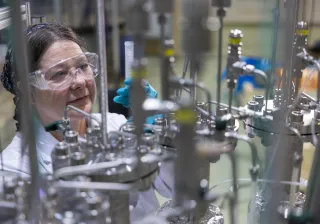Engineering has been the tool of industrialization for the last two hundred years, providing machines, infrastructure, and consumables. It is based on natural sciences, which builds on models formed by mathematics. After eliminating all noise caused by measurement, it becomes possible to fit the results in a perfect mathematical form. Behind all of this is the assumption of clear dependencies which control physical phenomena. Applying programming at a later time in calculation, production, and communication has extended the same principles in all fields of life with a great deal of success.
Nothing real is linear and we fail at simplifying
Still, we are trying to solve even the most complex problems of our time with a linear and reductionist approach. We are encouraged by past success and ease to understand simple models. In real systems, not only one model is sufficient to describe complexity, but multiple sets of dependencies are valid simultaneously, as is the history of development. Complexity demands nonlinear and dynamic models, which are difficult or even impossible to comprehend.
Our minds are not only extended but also diluted in their ability to control systems, which are increasingly larger and more complex. Artificial intelligence can handle multiple levels of phenomena. Large language model-based chatbots apply to benefit very large bodies of data. Adding complexity ultimately becomes chaotic: a system without stabile conditions. Now it has become important to study interactions between the complex systems.
Linear production and consumption models are as yet dominant. It is the simplest and most profitable approach to think about resources, raw materials, workers and the environment in the short term. Generally, utilization of all resources is based on competition in markets but is missing the factors related to actual impact on nature and society. Prize development is predictable and partially automized, but secondary consequences become visible only with more complex research with the help of, e.g., modern technologies from satellites to supercomputing models.
Resource limitations are guiding development
The world’s economic system based on fossil fuels and continuous increase of productivity and consumption has been shown to be an impossible equation but is the one which has been set in place and changeover can only happen from the inside and gradually. The solution, for example, of the energy question, has been touted as being bioenergy, based on the belief that peak oil can be solved with renewables. We are close or have even already reached peak bio, and now emission-free sources are the issue. However, energy will be one of the major drivers of growth in any future scenario.
Raw materials are achievable from recycling as well, and sustainably so if logistics and processes are properly designed. In general, it is assumed that all recycling is good, which is unfortunately believed to be that simple. Systems depend on cultures, localities, and various availabilities. Concepts and their performance should be valorized case-by-case with methods like life cycle assessment. Generally, however, it can be said that the shorter the recycling route, the easier it is to make it sustainable.
Materials that are rare, expensive or energy-intensive seem to be the most attractive for recycling. Low-cost bulk materials are complicated to recycle in an economically viable way, especially if the materials are mixed. In these applications, it should be normal procedure to take recycling into account while products are designed. For example, the demands of light weight and high performance makes designing for recycling challenging. A typical example could be food packaging.
Reuse of materials is an emerging answer for material recycling challenges. There are many positive aspects of minimizing virgin raw material usage and avoiding manufacturing by ensuring long service lives of products. Textiles are consumption products which are obvious for reuse, especially if culture allows. In contrast, reusable packaging has caused discussion, while transportation, washing and a number of reuse cycles may vary markedly between different applications.
Both recycling and reuse have been applied at all times, especially in crises and depression periods. The collection and recycling of paper board, glass, and metals has been proven to be feasible while the same processes for, e.g., plastic or composites, have not. The problem of mixed material in shorting and fractioning does not yet have good solutions. Only recently, the development of ICT has opened possibilities in the future to follow individual products instead of analyzing average compositions of unknown mixed waste. Only now do inventions like material passports and spectral cameras enable real control of material streams and increase products’ service-lifetime expectations.
The problem with renewing structures
Politics that support, e.g., biofuels have intensified their use and all side streams as well as large parts of renewable raw materials for material production are under vivid competition with being consumed as energy. On the horizon is not only carbon sinks in forests but also the threat of biodiversity. Similar problems are related in the production of all renewable raw materials. There is urgency to release bioenergy sources for material wood, while harvesting faces volume limitations.
Legislation around sustainability develops rapidly; new initiatives are coming up and not necessarily coherently. In complex systems, we must experiment to understand the system responses. In other words, we must make case studies in different contexts. The typical legislative action is to limit rather than guide or experiment with interventions. It may happen that technology or systemic solutions are fixed in a legislatively simplistic way. This creates a tendency to sustain contemporary systems and limit the option of using innovative new solutions.
Building new systems requires huge capital expenditure. New material economy evidently requires feasibility, which has been seen, e.g., recently when corona crises dropped fashion markets and launched prize competition. Sustainability via recycling and quality to increase self-lives remains, but the mainstream turns back to existing tradition. It is highly important for sustainable development, especially in consumer products, that products gain consumers’ acceptance. We can educate consumers and even create sustainable fashion. However, we cannot replace consumers, even though systems can be reoriented.
Simplified solutions are not resilient in variable situations and environments. Adaptation to continuously changing situations and boundaries requires continuous development. It becomes increasingly important to test responses of the systems and guide their development rather than set fixed rules and try to maximize them accordingly. In other words, to be successful in evolution, it is essential to continue learning.
Record of performance of anything has been traditionally the target of engineering motivated by a competition of increasing efficiency and economic benefit. Robust systems are not the highest performer in the short term, but they provide sustainability for the economy in the long term. It may lead to redefinition of growth, but it is also helpful to adapt to its boundaries. While the world remains in continuous change, business is not meant to produce more of the same faster and cheaper, but rather to benefit assets in the most sustainable manner.
Ali Harlin, Research Professor at VTT







